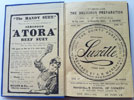THE BOOK OF ICES
INCLUDING CREAM AND WATER ICES, SORBETS, MOUSSES, ICED SOUFFLES, AND VARIOUS ICED DISHES, WITH NAMES IN FRENCH AND ENGLISH, AND VARIOUS COLOURED DESIGNS FOR ICES. BY A.B. MARSHALL. (Copyright.) REVISED AND ENLARGED EDITION. London: MARSHALL’S SCHOOL OF COOKERY, 32, MORTIMER STREET. SIMPKIN, MARSHALL, HAMILTON, KENT & CO., LIMITED, 4, STATIONERS’-HALL, COURT. [Price Half-a-Crown net.]
180 x 120mm. n/d. Front paste-down and end-paper with lovely advertisements. Half-title. On verso advertisement for all Marshall’s books. [1] Frontispiece – one of the four coloured plates. Title page with tissue guard. [1] (1)vi-vii Contents. [1] (1)2-52. (1)54-76 Advertisements featuring wonderful illustrated drawings of Marshall’s ice-moulds, ice-pots and machines. (1)78-79 Index. On verso advertisement for all Marshall’s dry goods. [1] End-paper and paste-down with lovely advertisements. Original bright blue cloth cover with blind tolled lines and bright gilt writing. Internally very clean with the four coloured plates with tissue guards. A lovely copy of this very scarce much sought after thin volume. Earlier copies were published without the plates and had limited advertisements.
- In Ivan Day's extremely interesting web-site "Historic Food" there is an article about the history of ice-moulds. It states "The tradition of making novelty ices in the form of vegetables, fruits and other food items seems to have started in late seventeenth Naples, where moulded sorbetti were known as pezzi duri (hard pieces). A pewter mould for making asparagus ices is illustrated in Gillier's 'Canammeliste Francaise' - Nancy: 1750. By the 1860s these moulds were to be found at ‘most ironmonger's', so bunches of ice cream or water ice asparagus (see image #6 below) seem to have become popular by this time with Victorian diners. They were frequently illustrated in nineteenth and early twentieth century cookery texts, such as this work by Marshall, also Theodore Garrett and John Kirkland. American mould manufacturers were still making asparagus moulds in the 1950s, though by this time, they had become much stouter in order to facilitate easy demoulding. The earlier, narrow moulds are not easy to use, as the asparagus ices are difficult to turn out without breaking. They should be dipped into cold water for about twelve seconds and the ices rolled out onto a clean table napkin with the finger tips, rather than the point of a knife, which is usual with most other ice-moulds".--- If you go hunting thro' the stalls on Portobello Road, London, on a Saturday morning you will still be able to find those Victorian pewter or copper ice-cream moulds. The good ones can now cost hundreds of pounds. They are much sought after by serious collectors.






click on image to enlarge

Antiquarian category
ref number:
11146